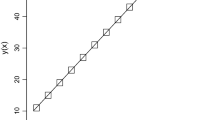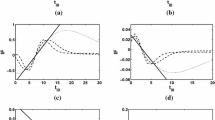Abstract
Non-additive measures have become a powerful tool in Decision Making. Therefore, a lot of problems can be solved through the use of Choquet integral with respect to a non-additive measure. Once the decision maker decides to use this criterion in his decision process, next step is to build the non-additive measure up. In this paper we solve the problem of learning the measure from sample data by minimizing the squared error. We study the conditions for the unicity of solution, as well as the set of solutions. A particular family of non-additive measures, the so-called k-additive measures, are specially appealing due to their simplicity and richness. We will use 2-additive measures in a practical case to show that k-additive measures can be considered as a good approximation of general measures.
Access this chapter
Tax calculation will be finalised at checkout
Purchases are for personal use only
Preview
Unable to display preview. Download preview PDF.
Similar content being viewed by others
References
Allais, M. (1953). Le comportement de l’homme rationnel devant le risque: critique des postulats de l’école américaine. Econometrica (21):503–546.
Banzhaf, J. F. (1965). Weighted voting doesn’t work: A mathematical analysis. Rutgers Law Review (19):317–343.
Chateauneuf, A., and Jaffray, J.-Y. (1989). Some characterizations of lower probabilities and other monotone capacities through the use of Möbius inversion. Mathematical Social Sciences (17):263–283.
Chateauneuf, A. (1994). Modelling attitudes towards uncertainty and risk through the use of Choquet integral. Annals of Operations Research (52):3–20.
Choquet, G. (1953). Theory of capacities. Annales de l’Institut Fourier (5):131–295.
Ellsberg, D. (1961). Risk, ambiguity, and the Savage axioms. Quart. J. Econom. (75): 643–669.
Grabisch, M., and Nicolas, J.-M. (1994). Classification by fuzzy integral-performance and tests. Fuzzy Sets and Systems, Special Issue on Pattern Recognition (65): 255–271.
Grabisch, M., and Roubens, M. (1996). Equivalent representations of a set function with application to decision making. In: 6th IEEE Int. Conf. on Fuzzy Systems.
Grabisch, M., Baret, J.-M., and Larnicol, M. (1997). Analysis of interaction between criteria by fuzzy measures and its application to cosmetics. In: Proceedings of Int. Conf. on Methods and Applications of Multicriteria Decision Making.
Grabisch, M., Marichal, J.-L., and Roubens, M. (2000). Equivalent representations of a set function with applications to game theory and multicriteria decision making. Mathematics of Operations Research 25 (2): 157–178.
Grabisch, M. (1995). A new algorithm for identifying fuzzy measures and its application to pattern recognition. In: Proceedings of Int. Joint Conf of the 4th IEEE Int. Conf. on Fuzzy Systems and the 2nd Int. Fuzzy Engineering Sysmposium, 145–150.
Grabisch, M. (1996). k-order additive discrete fuzzy measures. In: Proceedings of 6th Int. Conf. on Information Processing and Management of Uncertainty in Knowledge-Based Systems (IPMU) 1345–1350.
Grabisch, M. (1997a). Alternative representations of discrete fuzzy measures for decision making. Int. J. of Uncertainty, Fuzziness and Knowledge-Based Systems 5: 587–607.
Grabisch, M. (1997b). k-order additive discrete fuzzy measures and their representation. Fuzzy Sets and Systems (92):167–189.
Miranda, R, and Grabisch, M. (1999). Optimization issues for fuzzy measures. International Journal of Uncertainty, Fuzziness and Knowledge-Based Systems 7(6):545–560. Selected papers from IPMU’98.
Miranda, R, Grabisch, M., and Gil, P. (2002). An algorithm for identifying fuzzy measures with ordinal information. In: Grzegorzewski, P., Hryniewicz, O., and Gil, M. A., eds., Soft methods in Probability, Statistics and Data Analysis, Advances in Soft Computing. Heidelberg (Germany): Physica-Verlag. 321–328.
Miranda, P. (2002). Applications of k-additive measures to Decision Theory. Ph.D. Dissertation, University of Oviedo.
Owen, G. (1988). Multilinear extensions of a game. In: Roth, A. E., ed., The Shapley value. Essays in Honor of Lloyd S. Shapley. Cambridge University Press. 139–151.
Rota, G. C. (1964). On the foundations of combinatorial theory I. Theory of Möbius functions. Zeitschrift far Wahrscheinlichkeitstheorie und Verwandte Gebiete (2): 340–368.
Roubens, M. (1996). Interaction between criteria and definition of weights in MCDA problems. In 44th Meeting of the European Working Group Multicriteria Aid for Decisions.
Schmeidler, D. (1986). Integral representation without additivity. Proc. of the Amer. Math. Soc. 97 (2): 255–261.
Shapley, L. S. (1953). A value for n-person games. In Kuhn, H. W., and Tucker, A. W., eds., Contributions to the theory of Games, volume II of Annals of Mathematics Studies. Princeton University Press. 307–317.
Sugeno, M. (1974). Theory of fuzzy integrals and its applications. Ph.D. Dissertation, Tokyo Institute of Technology.
Walley, P. (1981). Coherent lower (and upper) probabilities. Technical Report 22, University of Warwick, Coventry, ( UK ).
Willard, S. (1970). General Topology. Sidney (Australia): Addison-Wesley Publishing Company.
Author information
Authors and Affiliations
Editor information
Editors and Affiliations
Rights and permissions
Copyright information
© 2003 Springer-Verlag Wien
About this chapter
Cite this chapter
Miranda, P., Grabisch, M., Gil, P. (2003). Identification of non-additive measures from sample data. In: Della Riccia, G., Dubois, D., Kruse, R., Lenz, HJ. (eds) Planning Based on Decision Theory. International Centre for Mechanical Sciences, vol 472. Springer, Vienna. https://doi.org/10.1007/978-3-7091-2530-4_3
Download citation
DOI: https://doi.org/10.1007/978-3-7091-2530-4_3
Publisher Name: Springer, Vienna
Print ISBN: 978-3-211-40756-1
Online ISBN: 978-3-7091-2530-4
eBook Packages: Springer Book Archive




